Nest Removal & Identification: A Guide From Wasp and Bee Exterminators
September 13, 2023
When Iowa wasps and bees don’t buzz off your property, Preferred Pest Control can help identify and safely remove the problem! With over 38 years of experience, our wasp and bee exterminators have a lot of experience identifying troubling bee and wasp nests throughout the Des Moines metro. Some nests or stinging pests are more harmful and dangerous than others, depending on the species of bees or wasps you’re dealing with. Understanding the severity of your bee or wasp problem can go a long way in keeping you and your loved ones safe. That’s why we’re sharing some of our pest control experiences when dealing with bee and wasp nests. The following series of Iowa wasps and bees list each species from least harmful to most harmful.
Preferred Pest’s experts don’t typically recommend homeowners try to get rid of a beehive or remove a wasp nest alone. Mishandling some nests can quickly lead to multiple stings and possibly an allergic reaction. Call a Des Moines pest control company if you need help identifying or removing a beehive or wasp nest on your property.
Honey Bee Nests
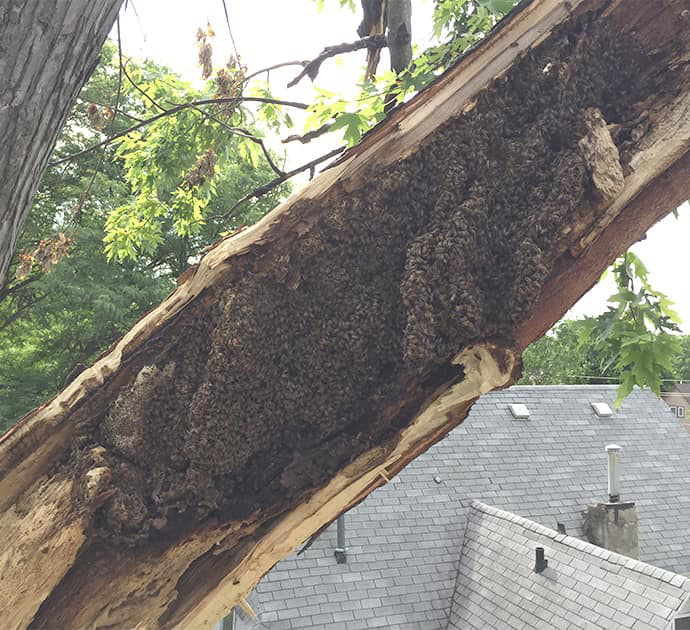
When a storm exposed a honey bee problem for a homeowner in the Valley Junction part of West Des Moines, they contacted our team for help. The storm caused a large branch to break off a tree and split open, revealing an active bee colony inside! We had to act quickly as these bees can create large colonies and cause a lot of trouble for homeowners.
What does a beehive look like?
Honey bee nests are made out of wax they secret from glands in their abdomens. Most of the hive is a series of interlocking hexagonal cells made of this wax called comb. Their nests are rarely exposed and often located within existing structures:
- Hollow trees
- Rock crevices
- Inside walls
While honey bees are the least aggressive stinging insects, contacting an exterminator is important to prevent the bee infestation from getting out of hand. If a honey bee hive is located in a structure on your property, you should also contact a local beekeeper. They will ensure the bees and honey will not be harmed in the bee removal process.
Carpenter Bee Removal
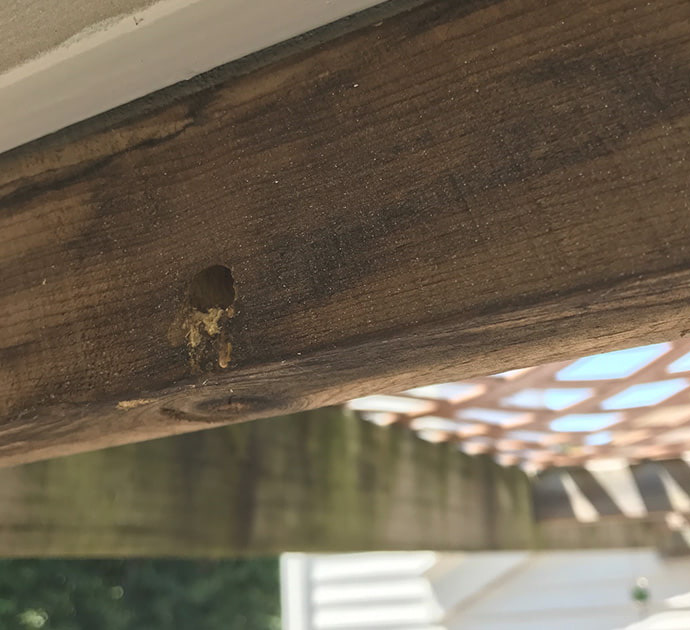
Carpenter bees are among Iowa's most common bee species and are especially active during the summer. As their name suggests, carpenter bees like to live and make their nests in wood. Females will eat away at bare, unfinished wood and dig out a hole that looks so perfect you would think a drill made it. After she digs a shallow hole about one inch deep, tunnels are excavated to the side, going with the wood grains. Carpenter bees will lay their eggs inside these tunnels and leave behind pollen and nectar for their larvae to eat. This species prefers to reuse their old nests so the female carpenter bees do not need to "drill" new holes yearly. When they continue to create new tunnels, this can cause quite a bit of damage over the years.
A carpenter bee infestation can be difficult to spot. A few common signs of an active carpenter bee nest are small holes in wooden structures and sawdust-looking debris around them. This species isn't known to be aggressive, but homeowners should inspect with decks and other wood structures to prevent damage. Having a professional bee exterminator take care of the problem can prevent future infestations — check out a video of Preferred Pest Control experts treating a carpenter bee problem!
Steel Blue Cricket Hunter Wasp in Iowa
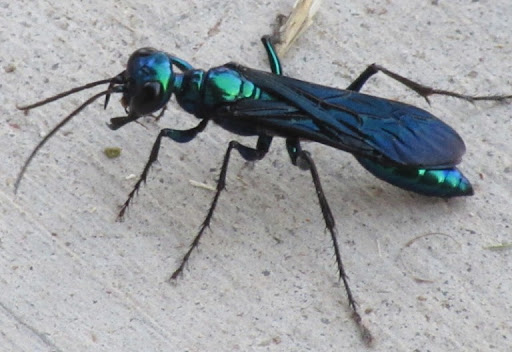
Steel blue cricket hunter wasps are unique in appearance, making them fairly easy to identify. They are larger wasps, about 1 to 1 ¼ inches long, and are a metallic blue. This species typically hunts crickets, which is how they got their name. These wasps are most common in July and August when crickets are most active and are virtually harmless to humans. The females are capable of stinging, and while they’ll often hover and put on a good show if you get too close to their nest, they rarely sting. Male steel blue cricket hunter wasps don’t have stingers.
This wasp species builds its nest in the soil, similarly to cicada killer wasps. In areas where both species reside, they will build nests in the burrows of cicada killer wasps. They prefer natural nesting sites:
- Rodent burrows
- Cavities in buildings
Cicada Killer Wasp Removal
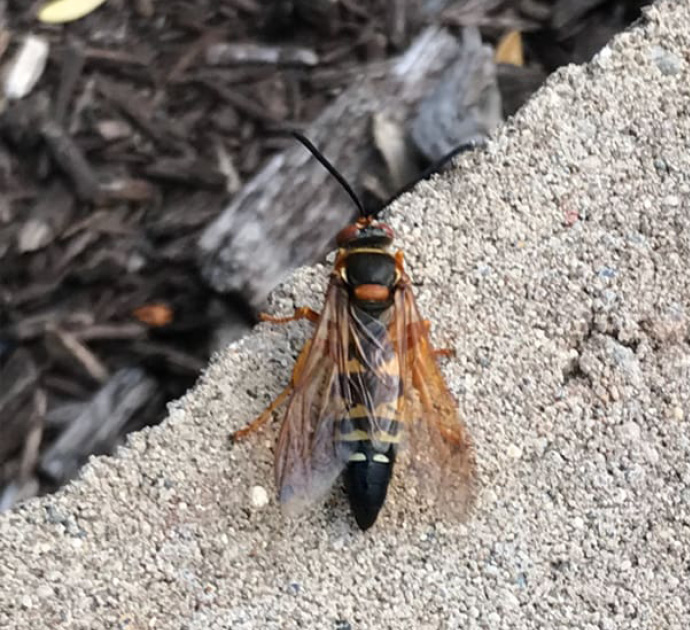
Cicada killer wasps are a solitary wasp that doesn’t live in a colony. They make their nests underground, making it very difficult to notice an infestation. A common sign of cicada killer wasps are the small dirt mounds that form when the female wasp is burrowing for a place to keep her larvae. The mounds are usually arranged in a slight curve and can most often be found in gardens. This wasp species gets the name “cicada killer” because they are a parasitic wasp that feeds live insects, typically cicadas, to its young.
When you see them around your yard, acting quickly is important. If you wait too long, you’ll have a group of cicada killer wasps around your property once the young inside the holes hatch. Despite their name, the cicada killer wasp is not harmful to humans unless they are disturbed or fear their nest is in danger. Cicada killer wasps are often mistaken for yellow jackets, a more aggressive species because they both have black and yellow stripes. However, cicada killer wasps have a more golden-brown coloring compared to a yellow jacket.
Paper Wasp Nest Removal
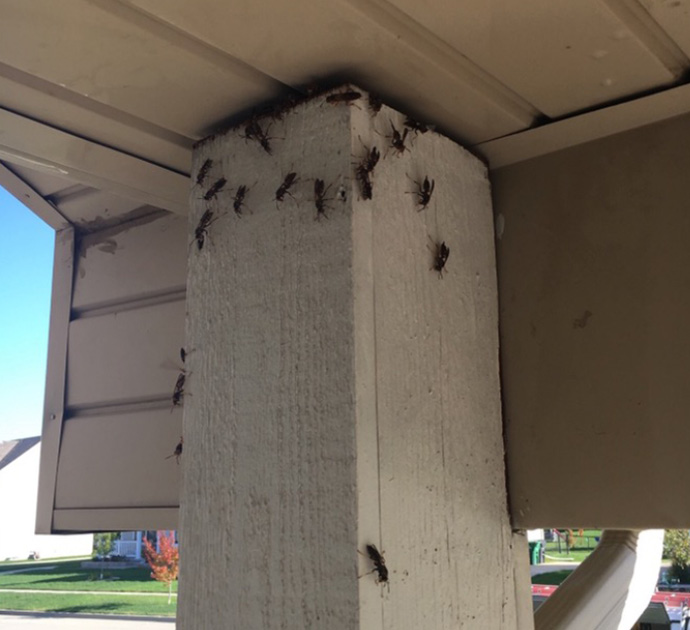
Paper wasps are a social wasp species in Iowa that forms colonies and live together in a nest. These Iowa wasps can expand their colonies in extremely small spaces. Our wasp exterminators were recently called to a home where a colony of paper wasps took over the pillar on the front porch by crawling between a small gap between the pillar and the overhang. Though paper wasps aren’t normally aggressive, they may sting if they feel threatened. Paper wasps can become especially aggressive towards the end of summer as their nest grows and they become more defensive.
What does a wasp nest look like?
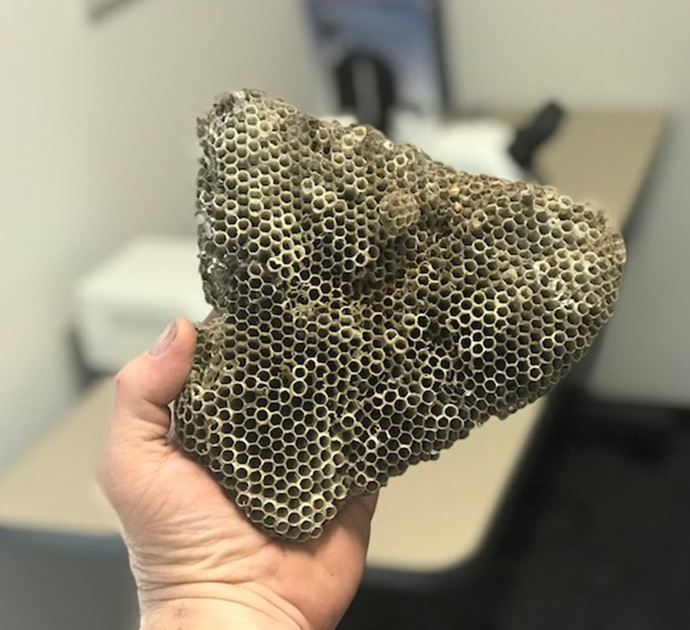
A paper wasp nest is made of chewed up leaves molded together by saliva from the wasps. The nest is open-faced with a bunch of hexagon-shaped openings to hold their larva.
Paper wasps get their name from the hive they create. The nests can get very large when they form a big colony and can be found under the eaves of your house, hanging on a branch, under deck railings and in attics. If you encounter a paper wasp nest or colony on your property, contact a pest control professional to avoid a dangerous or harmful situation. Our wasp exterminators at Preferred Pest Control can safely remove the nest and help prevent an infestation in the future.
Wasp Exterminator for Yellow Jackets
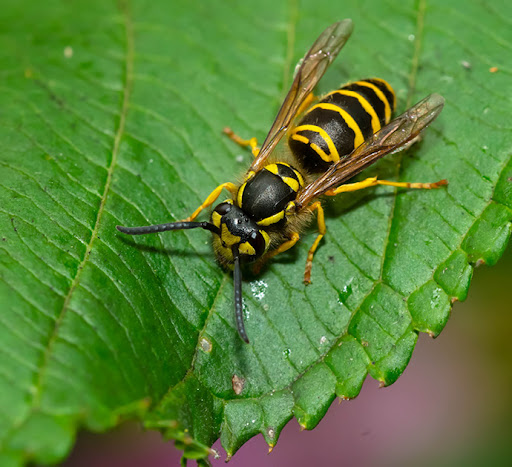
Yellow jackets are Iowa's most well-known wasp species and are typically easily recognizable with their distinct black and yellow markings. They are more aggressive than most Iowa wasps and bees and can sting multiple times when they feel threatened. Female yellow jackets are one of Iowa’s most common stinging insects. All females have stingers so they can paralyze prey and feed it to their young. The male yellow jackets do not have stingers. If you need help eliminating a yellow jacket nest or infestation, our Des Moines wasp removal experts can help.
Since they are social wasps with a colony to defend, yellow jackets are most aggressive in July and August, when they are most active. The yellow jacket queen lives through winter to start a new colony in the spring. Yellow jackets build their nests out of wood fiber that they chew into a paper-like pulp. These nests can be quite large and may house thousands of yellow jackets. They will often build their nest in protected areas or underground:
- Gopher holes
- Wood piles
- Dense vegetation
- Hollow logs
- Tree stumps
- Attics
- Between walls
- Under the eaves of your home
- Garbage bins
- Bushes and trees
Hornet Nest Removal
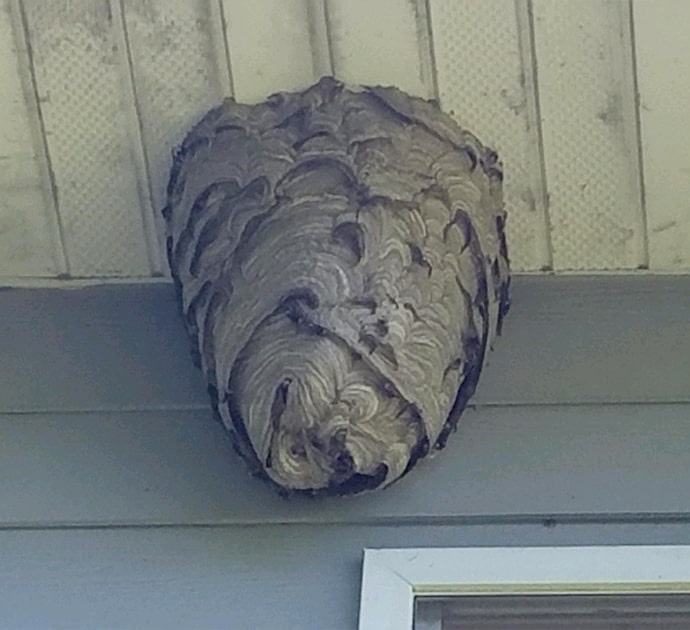
Hornets are a sub-species of wasps and are particularly aggressive compared to other stinging insects. They have a unique, bald face with white markings and black bodies. Attempting to remove or destroy a hornet nest on your own can be dangerous, even if you are not allergic to their venom. If you identify this species on your lawn or inside your home, we recommend calling hornet nest removal experts to avoid potential harm and painful stings, even if the nest appears small.
Hornets prefer to inhabit shady areas that protect them and their nest from the elements and will typically build their nests on existing structures. Their nests are made of a paper-like material, formed by combining their saliva with chewed-up wood pieces, and consist of hexagonal combs, an outer covering, and a single entrance.
Contact Preferred Pest Control’s Wasp & Bee Exterminators for Infestations and Wasp Nest Removal Services
Bees and wasps can wreak havoc on your property. If you encounter an infestation or need help identifying what type of pest you see, our Des Moines wasp removal and bee removal experts can help! Preferred Pest Control is the leading Des Moines pest control company, and we will remove a wasp nest or beehive safely and effectively. Don’t put yourself in danger — schedule an appointment online or give us a call at (515) 276-7277!